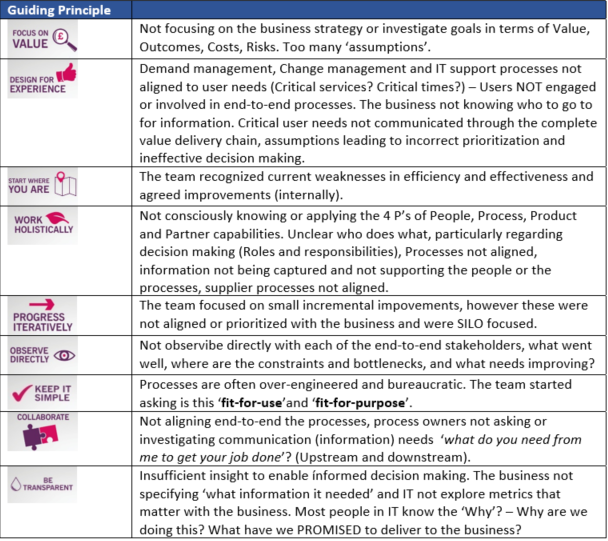Using ITIL Practitioner skills to impress the CEO
The IT500 Conference in Edinburgh was packed with hands-on workshops focusing on key IT related issues and trends, such as DevOps, SIAM, CSI, ITIL (Practitioner) and IT4IT.

Using ITIL Practitioner skills to impress the CEO
Together with Luci Allen from Pink Elephant, GamingWorks facilitated a Grab@Pizza business simulation focused on the ITIL Practitioner skills.
Delegates were challenged:
‘Can you demonstrate to the CEO that you REALLY are an ITIL expert in Practice’!
Luci kicked off the session explaining the Pink Elephant vision on ITIL Practitioner training. ‘…Yes you could just do the theory and try and pass the certificate, which is what we and many training organizations can provide, but we believe the real value comes from translating the theory into practice to solve recognized problems, which is why we use simulation games. A great way to bring the stakeholders together, to create buy-in, practice applying the theory and capturing some real life CSI items to take away’.
Paul then entered into his role as CEO of the company Grab@Pizza and challenged the teams. ‘There are more than 2 million ITIL certificates. You have been promising for years that ITIL will make things better. Look at these trends ‘70% of IT investments don’t deliver the necessary business functionality’ and ‘8.7 billion is lost annually as a result of outages’. Grab@Pizza is in trouble…SHOW me how you can turn the company around and how an ITIL Practitioner certificate will help’!

Grab@Pizza – A Business & Alignment simulation Grab@Pizza is a highly interactive, dynamic learning environment in which participants can translate theory into practice in a simulated case.
Grab@Pizza is the name of a successful company selling millions of Pizza’s every year. But after 6 months in the current year, the sales figures are far below expectations. IT is posing a significant business risk due to downtime and the inability of IT to respond to changing business needs (Risks). The CEO urged the Business Managers to make a challenging recovery plan. This plan is based on a 6-month strategy to bring the sales and profit back on target, to streamline operational processes and to improve the image and reputation of the organization (Value & Outcomes). Existing IT capabilities are poor, resources are tied up in ‘Keeping the lights on’ rather than supporting and enabling new innovations (Investment Costs). The IT department must ensure the appropriate capabilities are in place to execute the strategic plan and sufficient and effective resources are allocated to ensure both Value realization and Risk mitigation (Resource optimization).
The impact of theory!
We played the first round of the simulation which resulted in the CEO losing 20 million revenue opportunities (Value and Outcomes) and a loss of revenue of 16 million due to outages and downtime (Risks). ‘We didn’t spend all our IT budget’! proudly declared the IT Finance manager. The CEO was NOT amused.
“Groan………This feels like our daily work…I recognize a lot of this!’ said one delegate.
We looked at some of the ITIL Practitioner guidance and tools to explore and experiment if these could help. The team ALL had ITIL certificates, but having the certificate, and knowing the theory is not the same as being able to practically use the knowledge.
- We looked at the definition of a Service (nobody knew this) and nobody explored the ‘Value, Outcomes, Costs, Risks’ goals and NEEDS from the business. This is STILL the number 1 chosen ABC (Attitude, behavior, Culture) worst practice card chosen in global workshops with more than 3000 organizations. This is a top card year-in. year-out and has been for 15 years!!
- The team were familiar with the CSI model but did NOT begin with business vision, strategy and goals, they dove straight into ‘What needs improving’. Two other top scoring ABC cards are ‘IT is too internally focused’ and ‘ITIL is the goal NOT what you should be doing with it’.
We explored what went well and what went wrong in terms of the ITIL Practitioner guiding principles and what was common to real life experiences.

How can we improve the alignment to business value? The team then explored the COBIT goals cascade (as mentioned in the ITIL practitioner) to agree and align business goals, IT goals and identify 5 critical success factors.
We focused on CSI. Who is to take the lead? The team looked at each other, the eyes finally resting on the combined BRM / SLM role in the game. Why this role? This role was seen as a linking pin between the business and IT.
The team ‘Observed directly’ with each stakeholder in the game what their issues and needs were, in relation to the business goals, these were recorded on a CSI register.
It was agreed they could not improve everything. They must ‘progress iteratively’, choices needed to be made. How would they prioritize which CSI improvements they would implement? They invited the business to the CSI meeting to ‘Focus on value’ and ‘Design for experience’. The focus was balancing improvement decisions around value and outcomes against costs and (acceptable, conscious) risks.
It was also clear that some of the CSI improvement actions would automatically alleviate the needs of other process managers. E.g. ‘Implementing BRM capability would not only help align strategic business and IT goals, but could also then give more input into the change planning and prioritization need and to Service desk need for improved understanding of business impact to support prioritization’.

The business manager holds up his strategic plan against the CSI register that was built by the end-to-end team and prioritized against the business goals.
Theory to practice….Knowledge to RESULTS!
In the second round we had the lowest amount of lost revenue in the last 7 months and we hit our profit targets by deploying a new web-based ordering solution on time!…..The CEO was happy, the business was happy, IT was happy…… Imagine if we could achieve the same results in our own organization!!!
At the end of the day we asked people ‘What are your key takeaways? What will you take away and do differently, based upon this experiential learning exercise?
- Play the simulation with senior business and IT managers, have them switch roles and let them feel the ‘Pain’ , let them get together at the CSI board and agree improvements, and agree what ‘matters’ (Focus on value).
- We have SILO’d CSI registers, this was a powerful exercise in ‘collaboration’ – engage the end to end stakeholders to agree and align CSI initiatives and prioritize these.
- Collaboration: As an Ops manager/Process manager I don’t NEED to design the processes and tell people. I can facilitate this type of session and empower them to make improvements to their own work – ‘start where you are’, ‘observe directly (end-to-end) and keep improvements simple ‘fit-for-use?’ (to gain their buy-in) and ‘fit-for-purpose’ – how does it deliver value and enhance the customer experience.
- Engage with the business and the board. Using the COBIT goals cascade can help the dialogue. Look more into the BRM role for facilitating this. Also make some visible transparent wins to gain trust and credibility, show them some facts and figures demonstrating either Value or removal of a barrier (risk).
- Frustrated! I don’t see this happening in our organization! They want Agile and don’t want any structure or controls. The board needs to feel the pain. I can’t get them to attend an event like this! Suggestion from team: Gather facts and figures that show how you can add value, or gather real life business impact of changes that went wrong). Observe directly, make it transparent and show the impact Value is a good way to get their attention.
- The power of the Visual Management System, when we made the CSI register visible for all, when we made the strategic changes visible to all it made informed decision making a lot easier and fostered dialogue and collaboration among stakeholders.
- The need to focus on value. Use VOCR continually. Hang up the ‘Guiding principles’ and refer to these consistently as a ‘mirror’, are we focusing on the right things?

Some delegates said they would take away the 9 Guiding Principles and hang them on the walls.
Conclusion: Delegates found this type of experiential exercise a powerful way to not only translate theory into practice, but to foster collaboration, improve communication, to create buy-in and capture concrete actions to take away. Is that what YOU would like? Or would you rather just have the 2 day ITIL Practitioner and the certificate……go and ask the CEO which one he or she would prefer!!
Written by Paul Wilkinson, GamingWorks
